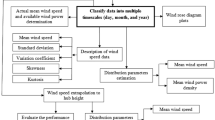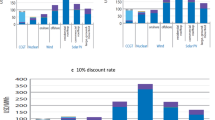Abstract
Wind power project development investment is based on the separate technical and financial analyses. Based on the actual wind data, data-based wind distribution map and wake effect model, a combined techno-economic analysis is proposed in this paper. Starting from deriving the wind distribution map, a comprehensive analysis extending to the feasibility assessment of the project is presented here. The problem is formulated as the maximization of net present value of the project subject to the specified initial investment cost within a fixed area and turbine spacing constraints. Simultaneous optimization of the wind turbine size, hub height and placement is realized with BPSO-TVAC. Sensitivity analysis and Monte Carlo simulation are used to investigate the feasibility of the project, against various parameters, imposed on by the techno-economic constraints. Hypothesis testing with a confidence level of 99.99% corroborates the results obtained from Monte Carlo simulation. With scenario analysis, a positive NPV is identified even in the worst-case scenario, an attractive trait for investors. An ideal decision-making tool considering technical efficiency and profitability simultaneously is presented.















Similar content being viewed by others
References
Patel MR (2006) Wind and solar power system, 2nd edn. Taylor & Francis, New York, pp 81–82
Pookpunt S, Ongsakul W (2016) Design of optimal wind farm configuration using a binary particle swarm optimization at Huasai district, Southern Thailand. Energy Convers Manag 108:160–180
Emami A, Noghreh P (2010) New approach on optimization in placement of wind turbines within wind farm by genetic algorithms. Renew Energy 35:1559–1564
Khanali M, Ahmadzadegan S, Omid M, Nasab F Keyhani, Chau KW (2018) Optimizing layout of wind farm turbines using genetic algorithms in Tehran province, Iran. Int J Energy Environ Eng 9(4):399–411
Evangelopoulos VA, Georgilakis PS (2014) Optimal distributed generation placement under uncertainties based on point estimate method embedded genetic algorithm. IET Gen Transm Distrib 8(3):389–400
Kirchner-Bossi N, Porté-Agel F (2018) Realistic wind farm layout optimization through genetic algorithms using a Gaussian wake model. Energies 11(12):1
Chen Y, Li H, He B, Wang P, Jin K (2015) Multi-objective genetic algorithm based innovative wind farm layout optimization method. Energy Convers Manag 105:1318–1327
Pookpunt S, Ongsakul W (2013) Optimal placement of wind turbines within wind farm using binary particle swarm optimization with time-varying acceleration coefficients. Renew Energy 55:266–276
Guirguis D, Romero DA, Amon CH (2016) Toward efficient optimization of wind farm layouts: utilizing exact gradient information. Appl Energy 179:110–123
Park J, Law KH (2015) Layout optimization for maximizing wind farm power production using sequential convex programming. Appl Energy 151:320–334
Pillai AC, Chick J, Khorasanchi M, Barbouchi S, Johanning L (2017) Application of an offshore wind farm layout optimization methodology at Middelgrunden wind farm. Ocean Eng 139:287–297
MirHassani S, Yarahmadi A (2017) Wind farm layout optimization under uncertainty. Renew Energy 107:288–297
Wang L, Cholette ME, Zhou Y, Yuan J, Tan AC, Gu Y (2018) Effectiveness of optimized control strategy and different hub height turbines on a real wind farm optimization. Renew Energy 126:819–829
Amaral L, Castro R (2017) Offshore wind farm layout optimization regarding wake effects and electrical losses. Eng Appl Artif Intell 60:26–34
Zeljko D, Milulovic J (2012) Assessment of the wind energy resource in the South Banat region, Serbia. Renew Sustain Energy Rev 16:3014–3023
Shata A S Ahmed, Hanitsch R (2006) Evaluation of wind energy potential and electricity generation on the coast of Mediterranean Sea in Egypt. Renew Energy 31:1183–1202
Serrano-Canalejo C, Sarrias-Mena R, García-Triviño P, Fernández-Ramírez LM (2019) Energy management system design and economic feasibility evaluation for a hybrid wind power/pumped hydroelectric power plant. IEEE Lat Am Trans 17(10):1686–1693
Gul M, Tai N, Huang W, Nadeem MH, Yu M (2019) Assessment of wind power potential and economic analysis at Hyderabad in Pakistan: Powering to local communities using wind power. Sustain 11(5):1
Chaurasiya PK, Kumar VK, Warudkar V, Ahmed S (2019) Evaluation of wind energy potential and estimation of wind turbine characteristics for two different sites. Int J Ambient Energy 1:1–11
Brogna R, Feng J, Sørensen JN, Shen WZ, Porté-Agel F (2020) A new wake model and comparison of eight algorithms for layout optimization of wind farms in complex terrain. Appl Energy 259:114189
Song D et al (2020) Optimal design of wind turbines on high-altitude sites based on improved Yin–Yang pair optimization. Energy 193:116794
SW, PDJ, HT (1995) A Manual for the Economic Evaluation of Energy Efficiency and Renewable Energy Technologies. NREL Tech Rep NREL/TP-462-5173
González JS, Rodríguez ÁGG, Mora JC, Payán M Burgos, Santos JR (2011) Overall design optimization of wind farms. Renew Energy 36:1973–1982
Mora EB, Spelling J, van der Weijde AH, Pavageau E-M (2019) The effects of mean wind speed uncertainty on project finance debt sizing for offshore wind farms. Appl Energy 252:113419
Shin H, Baldick R (2018) Mitigating market risk for wind power providers via financial risk exchange. Energy Econ 71:344–358
Judge F et al (2019) A lifecycle financial analysis model for offshore wind farms. Renew Sustain Energy Rev 103:370–383
Afanasyeva S, Saari J, Kalkofen M, Partanen J, Pyrhönen O (2016) Technical, economic and uncertainty modelling of a wind farm project. Energy Convers Manag 107:22–33
Pookpunt S, Ongsakul W (2016) Design of optimal wind farm configuration using a binary particle swarm optimization at Huasai district, Southern Thailand. Energy Convers Manag 108:160–180
Jensen NO (1983) A Note on Wind Generator Interaction. Riso National Laboratory, Riso National Laboratory RISO-M-2411, Nov 1983
Sun H, Yang H (2020) Numerical investigation of the average wind speed of a single wind turbine and development of a novel three-dimensional multiple wind turbine wake model. Renew Energy 147:192–203
Pierrot M (2005) Wind turbines and wind farms database. http://www.thewindpower.net/manuturb_turbines_en.php
Ananjavanich P (2015) Thailand: Renewable Energy Policy Update. In: Chrometzka T (ed) New Power Development Plan announced in May (Status May 2015). German Federal Ministry for Economic Affairs and Energy: German Federal Ministry for Economic Affairs and Energy, p 4
Service D. o. t. T. I. R. (2015) How To Depreciate Property. vol Publication 946, D. o. t. T. I. R. Service, Ed., ed. Department of the Treasury Internal Revenue Service: Department of the Treasury Internal Revenue Service, p 114
Saeed MA, Ahmed Z, Yang J, Zhang W (2020) An optimal approach of wind power assessment using Chebyshev metric for determining the Weibull distribution parameters. Sustain Energy Technol Assessm 37:100612
Eurek K, Sullivan P, Gleason M, Hettinger D, Heimiller D, Lopez A (2017) An improved global wind resource estimate for integrated assessment models. Energy Econ 64:552–567
Author information
Authors and Affiliations
Corresponding author
Additional information
Publisher's Note
Springer Nature remains neutral with regard to jurisdictional claims in published maps and institutional affiliations.
Rights and permissions
About this article
Cite this article
Pookpunt, S., Ongsakul, W. & Madhu, N. A comprehensive techno-economic analysis for optimally placed wind farms. Electr Eng 102, 2161–2179 (2020). https://doi.org/10.1007/s00202-020-01014-6
Received:
Accepted:
Published:
Issue Date:
DOI: https://doi.org/10.1007/s00202-020-01014-6




